
Taiyuan (太原) which literally means Great Plain is the capital and largest city of Shanxi Province. It lies at the fertile upper basin of Fen River. The history of Taiyuan began in Spring Autumn Period (春秋战国 770-460 BC) when Zhao State Kingdom made it as its capital in year 497BC. It was first named as Jinyang (晋阳) but later renamed as Taiyuan by Qin Kingdom after its conquest in year 228 BC. During 6th century, it became a base to the dynasty founder of Tang, Li-Yuan and his successor Li-Shimin, who relied heavily on the support of its local aristocracy. Both Li-Yuan and Li-shimin were from Taiyuan. As Tang Dynasty (618-907) progressed further, Taiyuan grew into a heavily military base and was periodically designated as a north capital known as Beidu (北都). Taiyuan was destructed in year 960 and rebuilt 22 years later during Song Dynasty (960-1279). In later part of Song Dynasty, it has turned into a superior prefecture and an administrative capitol of North Shanxi. Taiyuan continuously retained its status until end of Yuan Dynasty (1271-1368). During Ming and Qing Dynasty (1368-1644-1911), it once again gained back the position as the capital of Shanxi till this day. Today the historic Taiyuan City has become one of the great industrial cities of China, but the heritage from its glory past still is the spot of attraction to many who have keen interest in China's history.


Shanxi Museum located at the West Bank of Fen River, is an important landmark of cultural building in the capital and largest city of Shanxi Province, Taiyuan City. The site was originally an educational library that was established in year 1919. Shanxi Government invested nearly 400 million yens to turn it into a modern and comprehensive museum in August 2004. It was the largest investment in the cultural infrastructure of the State. The complex covers a total land area of 112k sq. meter in which 51k sq. meter is occupied with buildings. The entire building with its grand modelling, looks like a mountain, a piece of elegant and pleasing architectural art. It has one main hall and four subsidiary building structures. The Main Hall utilizes the modern technology to interpret the thought of ancient people on architecture. It symbolizes harvest, stability and prosperity. Office Building, Conference Center, Art Center and Exhibition Hall are at the four corners of the main building.


The Museum collects more than 200k historical relics and artifacts, which is considered the largest heritage collection in Shanxi Province. In addition, it has 270k volumes of books stored in its library completed with basic facilities and proper system. The area covered for the library is 1000 sq. meter.


Many of its extensive collections dating back to Spring Autumn period (770-476BC).




The unearthed ancient decorative necklace and The illustration of ancient tombs where charcoal and rocks were used to avoid humidity and prevent tomb theft. The practice of using the charcoal in the tomb started during the era of West Zhou (1046-771 BC) and later developed into putting charcoal with the rock in Spring Autumn period (770-476 BC), making the tomb more solid and stabilized.



The innovative cart full of animals and a prisoner with left leg cut off was the most valuable treasure from Spring Autumn period (770 - 476 BC) unearthed in Shanxi. The covered cart had 6 wheels with a door that could be opened in front. An one footed prisoner stood by the side of the door. There are different animals on the top and around the four sides of the cards. The 4 birds standing at four corners are moveable. It was well known in China as Yue-ren-shou-you 刖人守囿 which means a cart of animals was guarded by a prisoner with his left leg chopped off.



Fascinating collection !










The two ancient pillows relics are interesting especially the one with tiger design. Each design has its own meaning.


Jade Relics
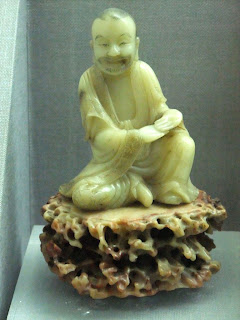

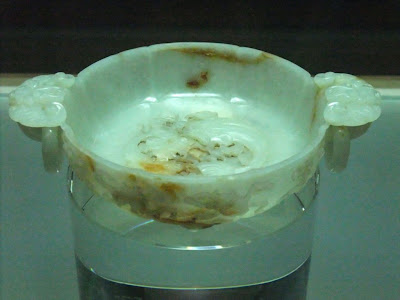
Ancient calligraphy is among the relics.
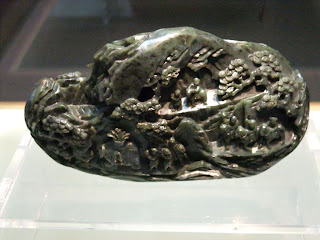


A section of ancient coins and relics related to Spring Autumn era.


The ancient Chinese started using money coins dating as early as in the first Dynasty of China (Xia Dynasty 2070-1600BC). The earliest coins were natural sea shell and when demand became greater, stone and brass shell were also circulated in the market. Chinese currency was later standardized by units called banliang (半两) by Qinshiwang (秦始皇 259-210 BC) after he unified the continent of China in year 221 BC.



Coins were gradually developed into bills of exchange in Qing Dynasty (1644-1911).



Shanxi Museum is the home to some of the oldest history in China.



The accounting ledger books and records used in the olden days.



Fresco, painting and carvings.



The City of Taiyuan was a center of Buddhism between years 534-577 during the period of Eastern Wei and North Qi Dynasty. Emperors and eminent persons placed high esteem on the religion making great influences throughout the land during the period of Sui and Tang Dynasty, when Buddhism reached its prime. Buddhist Arts rapidly developed with resplendence.



Buddha Images were the main source for China sculpture arts for a long time in ancient China. Most images used durable materials like stones, gold, metals or colored hard clay. Early Buddhist Sculptures were stamped with a strong Indian style but gradually Chinese style was adapted.



Eternal Beauty of Buddha Images.







These are hand written Buddhist Sutra. Some of them were the hand writing of Emperors.





Illustrations of all famous ancient Buddhist Temples in Shanxi Province are in the exhibition hall. The Temple of Chongfu-si (崇福寺)located at Shuozhou (朔州) was the only temple we had missed. The temple was built in year 1143 and the sculptures dating back from Jin Dynasty, housed in its Mi-Tuo Hall (弥陀殿) are all well preserved. It was recorded that its Buddhist Canon Court was first constructed in year 665 during Tang Dynasty.



Temple of Guanyin-Tang (观音堂) at Chang-zhi city of Shanxi (长治市) is also a preserved old temple. It has a history of 420 years since it was built in year 1582. The temple has about 500 relics from Ming Dynasty at the site. The fabulous 12 Bodhisattva sculptures (十二圆觉像) are one of them. The image of 1000 hands and eyes Goddess of Mercy was a replica of the one from Temple of Shuanglin-si at Pingyao City (平遥双林寺).




Temple of Chongshan-si (崇善寺) lies at a serene lane by the eastern side of Taiyuan City. The site was originally established as a resort palace by Emperor Suiyang 隋煬帝 in late Sui Dynasty. The site was later expanded and renovated by the 3rd prince of the first Emperor of Ming Dynasty (Zhu-yuan-zhang 朱元璋), in memory of his mother. The extended temple was large in scale and grand in appearance but unfortunately it was destroyed by a fire in year 1864. The entrance gate, Hall of Dabei-dian, Bell Tower and East-West living quarters are the few structures remained. The place now serves as an office for The Shanxi Buddhist Association.


The building of Chongshan-si is a typical architectural style of Ming Dynasty. The two brass lions at the gate were believed to be hand-crafted in Ming Dynasty.
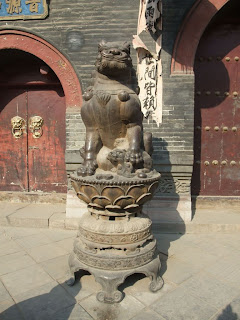


The Bell Tower is nearly 5-600 years in history.



The Ming styled Hall of Dabei-dian (大悲殿) is the main structure in the complex.



The three images of eleven direction thousand eyes and hands Goddess of Mercy, Bodhisattva Manjushri and Samantabhadra (11 面千手千眼观音菩萨`,千钵菩萨和普贤菩萨), enshrined in Dabei-dian are the most renowned. The gorgeous sculptures are so extra-ordinary in its carving skill, its posture and its bright colors, which fully reflects the high standard of carving technology in Ming Dynasty.




A view of Dabei-dian (大悲殿) and the living quarters (东西厢房),which are the two structures that remains from Ming Dynasty.


With a local's guarding, we had a wonderful lunch at this tradition restaurant in Taiyuan Town.
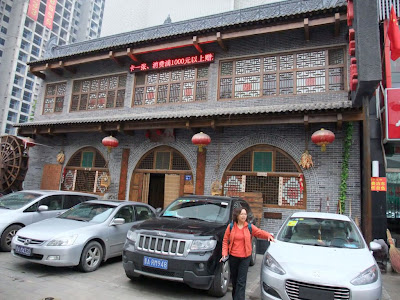


We love its set up and decoration, appears quite Japanese way, but its Chinese.


All windows are covered up with paper as practiced in ancient time. The ancient coins lamp hanging above each table is antique and gorgeous.


Lily is a typical Taiyuan lady, enthusiastic, friendly, hardworking and very efficient. She knows Taiyuan well. She told us the first thing to know in Shanxi food culture is to learn how to take vinegar, which is the most essential food essence in their daily life.


Fermented bean curd (Taufoo), potato straws, fried millet are some of its authentic vegetarian delicacy. They were delicious and nutritious as well.



Shanxi staple food is noodle. There are so many types and in so much varieties and taste. Another popular dish is the cold dish that hand made from glutinous rice. All are vegetarian.


Some of the process in making the cold glutinous dish.



Another famous dish in Shanxi cuisine is its wheat made "liangfen" (凉粉), kind of snacks. They can be prepared either in cold or hot and make into various shape. The most well-known is the cat ear "liangfen" (猫耳朵) boiled in stone pot in vegetable soup.



We had this bean curd skin stew dish as dinner and the taufoo (bean curd) pudding with salted vegetable in this little store as breakfast. Southern Asians take taufoo pudding with sweet syrup (豆腐花) as dessert but northern Chinese take it with salted vegetable and crispy gruller (油条豆脑) as breakfast.



Taiyuan Bus Station is the landmark of Taiyuan City.


Some outstanding building at town.



Taiyuan is a heavy industrial city and beware of highly air pollution in the city, bicycles and electric scooters are widely used at town besides the not so environmental friendly vehicles like cars and motorbikes.



No comments:
Post a Comment